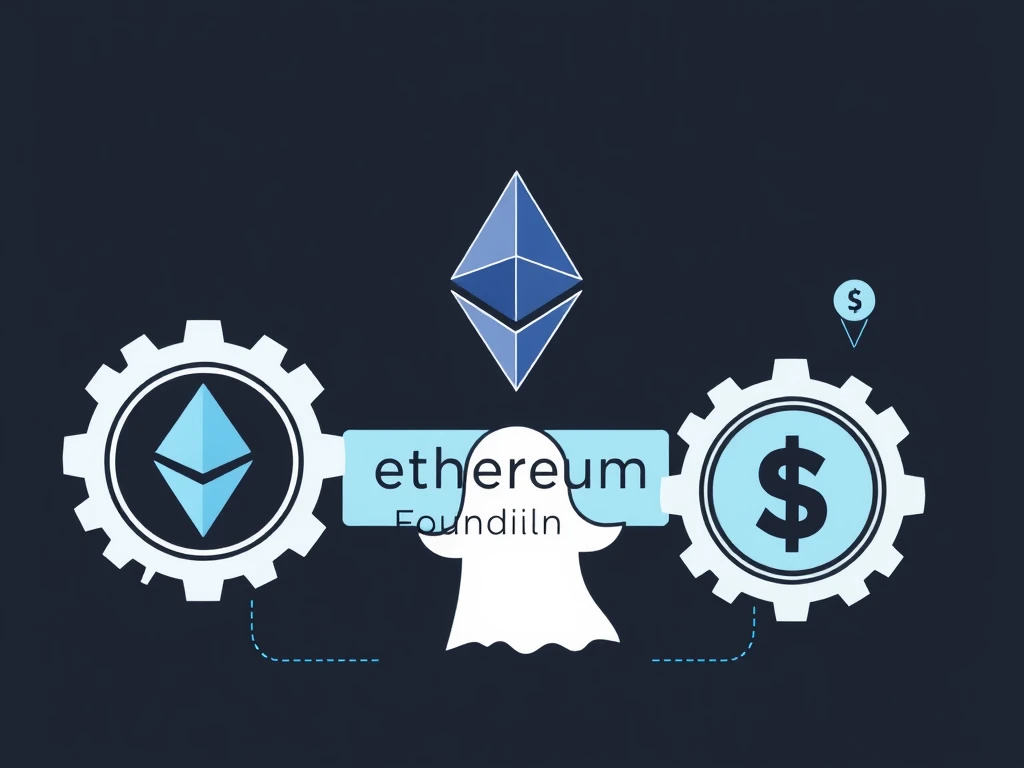Major Shift: Ethereum Foundation Embraces DeFi for Treasury Management

Big news from the world of Ethereum! The Ethereum Foundation, the non-profit organization supporting the Ethereum ecosystem, is making a significant change in how it manages its funds. Instead of just selling off Ether (ETH) to cover costs, they are now diving deeper into the world of Decentralized Finance (DeFi).
Ethereum Foundation’s Strategic Move into DeFi
The latest development signals a maturing approach to treasury management within the crypto space. The Ethereum Foundation has actively started using DeFi protocols for more than just holding assets. A key move reported recently involves borrowing stablecoins.
- The Foundation borrowed $2 million in GHO, a decentralized stablecoin from the Aave protocol.
- According to Aave founder Stani Kulechov, the EF is now both supplying ETH to Aave and borrowing from it.
- Kulechov described this as completing “the full DeFi circle.”
This strategic shift suggests the Foundation is exploring ways to utilize its substantial ETH holdings without directly liquidating them on the open market, a practice that has drawn criticism in the past.
Leveraging Aave and Other DeFi Protocols
The move to borrow GHO specifically highlights the Foundation’s trust in established DeFi platforms. GHO is an overcollateralized stablecoin governed by the Aave DAO, offering a decentralized alternative to centralized stablecoins.
This isn’t the Foundation’s first foray into DeFi. They previously deployed a significant amount of ETH across various protocols:
| Date | Action | Amount (ETH) | Value (approx) | Protocols Involved |
|---|---|---|---|---|
| February (Previous) | Deployment into DeFi | 45,000 | $120 million | Aave, Spark, Compound |
| May (Recent) | Borrowing | N/A (Borrowed GHO) | $2 million (GHO) | Aave |
This earlier deployment was called the Foundation’s “biggest allocation in DeFi” at the time, indicating a growing comfort level and strategic intent to engage with the decentralized financial ecosystem.
Why Use Stablecoins?
Borrowing a Stablecoin like GHO allows the Ethereum Foundation to access capital for operational expenses or investments without selling its underlying ETH. This is a common strategy in DeFi: deposit volatile assets (like ETH) as collateral and borrow stable assets (like GHO or USDC) against them. This way, the Foundation can retain its ETH holdings, potentially benefiting from future price appreciation, while still having access to funds for immediate needs.
Addressing Past Criticisms of ETH Sales
For a while, the Ethereum Foundation faced criticism from community members regarding its practice of selling ETH to fund operations. Prominent figures like Eric Conner and Anthony Sassano suggested alternatives, specifically recommending staking ETH or using DeFi lending protocols to borrow stablecoins against their holdings instead of direct sales.
The Foundation’s recent actions directly address these concerns, demonstrating a shift towards the very strategies the community advocated for. This pivot is seen by many as a positive step, aligning the Foundation’s financial practices more closely with the innovative potential of the ecosystem it supports.
Community Reaction and Future Outlook
The community response to the Foundation’s deeper engagement with DeFi, particularly the borrowing activity on Aave, has been largely positive. Many view it as a win for the ecosystem and a sign of responsible treasury management. It signals that the Foundation is not just building the technology but also actively using the decentralized tools available within it.
This move could set a precedent for other large holders or organizations within the crypto space looking for sophisticated ways to manage assets without resorting to frequent market sales. It underscores the growing utility and maturity of DeFi protocols as legitimate financial tools.
Summary
The Ethereum Foundation’s decision to borrow $2 million in GHO from Aave, following a previous $120 million deployment into DeFi, marks a significant evolution in its treasury management strategy. By supplying ETH and borrowing stablecoins on platforms like Aave, the Foundation is actively using the decentralized financial tools it helped create. This strategic pivot away from potentially controversial ETH sales aligns with community suggestions and highlights the increasing sophistication and practical application of DeFi in managing significant crypto holdings.









